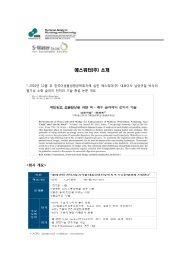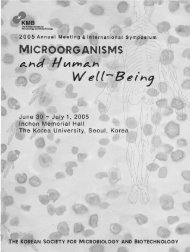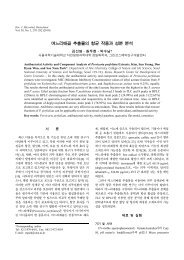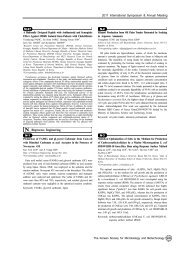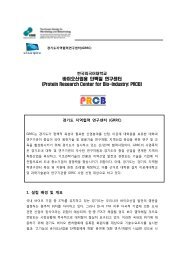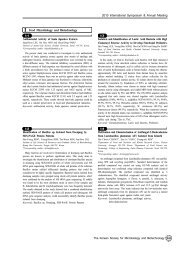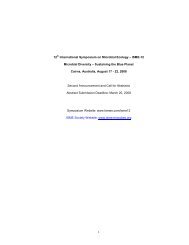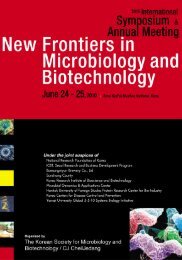J_Environmetal Microbiology and Engineering
J_Environmetal Microbiology and Engineering
J_Environmetal Microbiology and Engineering
You also want an ePaper? Increase the reach of your titles
YUMPU automatically turns print PDFs into web optimized ePapers that Google loves.
J-32<br />
Enhancement of Biohydrogen Production in [NiFe]-hydrogenase<br />
Expressing Recombinant Escherichia coli by Introducing Light<br />
Acceptor<br />
Younghwa JO, Jaoon Y.H. KIM, Byung Hoon JO <strong>and</strong> Hyung Joon CHA*<br />
Pohang University of Science <strong>and</strong> Technology, Pohang 790-784, Korea.<br />
*Corresponding author: hjcha@postech.ac.kr<br />
Biohydrogen production can be one of solutions for energy crisis.<br />
Previously, we successfully demonstrated the production of biohydrogen<br />
by constructing [NiFe]-hydrogenase-expressing recombinant E. coli.<br />
Although [NiFe]-hydrogenase showed relatively high oxygen-tolerance<br />
compare to other hydrogenases, still biohydrogen production efficiency<br />
was low. In this research, we introduced proteorhodopsin, light acceptor<br />
for prokaryote working as proton pump, into [NiFe]-hydrogenaseexpressing<br />
recombinant E. coli for utilizing light energy for producing<br />
biohydrogen. Proteorhodopsin need a chemical named retinal for working<br />
as proton pump by using light energy but E. coli does not have a pathway<br />
to synthesize it. In order to give E. coli an ability to synthesize retinal,<br />
we expressed five foreign genes expressing enzymes for retinal synthesis<br />
pathway. By introducing light accepting system into E. coli expressing<br />
[NiFe]-hydrogenase, we could get enhanced biohydrogen productivity.<br />
Keywords: Biohydrogen, [NiFe]-hydrogenase, proteorhodopsin<br />
Novel Probiotic Strains for American Foulbrood <strong>and</strong> Nosemosis<br />
of Honeybee<br />
Yoon Jeong JANG 1 , Byoung Joo SEO 1 , Irfan RATHER 1 , Uk Han CHOI 1 ,<br />
Jeonghuei LIM 1 , Kook Hee KANG 2 , Byoung Su YOON 3 <strong>and</strong><br />
Yong-Ha PARK* 1<br />
J-33<br />
1<br />
Department of Applied <strong>Microbiology</strong> <strong>and</strong> Biotechnology, Yeungnam University.<br />
2 3<br />
Korea Institute of Science <strong>and</strong> Technology Information, Daejeon. Department<br />
of Life Science, Kyonggi University, Suwon, Kyonggi-Do.<br />
*Corresponding author: joos02@ynu.ac.kr<br />
American Foulbrood of honeybees (Apis mellifera), caused by the<br />
Gram-positive bacterium Paenibacillus larvae is one of the most serious<br />
diseases affecting the larval <strong>and</strong> pupal stages of honeybees. Presently,<br />
Nosema ceranae <strong>and</strong> Nosema apis seems to be the main microsporidian<br />
infection in honeybees. The aim of this study was to evaluate lactic acid<br />
bacteria strains isolated from Kimchi <strong>and</strong> to study its inhibitory effects<br />
against Paenibacillus larvae subsp. larvae KCTC 3744 <strong>and</strong> Nosema<br />
trichoplusiae ATCC 30702. In all, 3,500 strains were screened <strong>and</strong> three<br />
highly active bacteria were selected <strong>and</strong> were identified as L. plantarum<br />
YML001, L. plantarum YML004, Leu. citreum KM20. The optical density<br />
of P. larvae KCTC 3744 at OD600nm showed drastic decrease in cell<br />
growth as compared to control. Three groups of honey bees (N=25) were<br />
given Nosema Spores at a concentration of 10,000 spores per ml with<br />
addition of 1% of supernatant of three strains. The bees were incubated<br />
at 37°C <strong>and</strong> samples were taken seven days post infection, <strong>and</strong> the amount<br />
of spores in the mid gut was counted. We found that the three strains<br />
inhibited the growth of P. larvae KCTC 3744 <strong>and</strong> N. trichoplusiae ATCC<br />
30702 <strong>and</strong> provided new perspective for probiotics of honeybees.<br />
Keywords: American Foulbrood, Nosemosis, Probiotics<br />
404 www.kormb.or.kr<br />
Analysis of Bacterial Community in Electrochemical Bioreactors<br />
Cultivated with Carbon Dioxide as Sole Carbon Source<br />
Doo Hyun PARK 2 , Jinsu KIM 2 , Bo Young JEON 2 <strong>and</strong> Il Lae JUNG* 1<br />
1<br />
Department of Radiation Biology, Environmental Radiation Research Group,<br />
Korea Atomic Energy Research Institute, Daejeon 305-353, Korea. 2 J-34<br />
Department<br />
of Biological <strong>Engineering</strong>, Seokyeong University, Seoul 136-704, Korea.<br />
*Corresponding author: baakdoo@skuniv.ac.kr<br />
Bacterial community was isolated from different sources that were forest<br />
soil, aerobic wastewater treatment reactant, anaerobic wastewater digestive<br />
reactant, farm field soils, mixture of isolated bacterial strains. Bacterial<br />
communities grown in the different bioreactors were analyzed by<br />
temperature gradient gel electrophoresis technique. Different bacterial<br />
communities were enriched <strong>and</strong> selected during cultivation with the<br />
electrochemical reducing power as a sole energy source. TGGE pattern<br />
is not an indicator to show all of the bacterial communities grown in<br />
the electrochemical bioreactors; however, the bacterial species capable of<br />
growing with carbon dioxide or surviving in the condition saturated with<br />
carbon dioxide may be enriched selectively. According to the bacterial<br />
species identified based on the sequence homology, various bacterial<br />
species may fix metabolically carbon dioxide. Acknowledgement This<br />
work was supported by the New &Renewable Energy of the Korea Institute<br />
of Energy Technology Evaluation <strong>and</strong> Planning (KETEP) grant funded<br />
by the Korea governmental Ministry of Knowledge Economy<br />
(2010T1001100334)<br />
Keywords: electrochemical reducing power, carbon dioxide fixation,<br />
Bacterial community diversity<br />
Screening of Protease-Producing Bacteria from Gastropods<br />
Jung-Hee WOO* 1 , Sun Mee HONG 1 , Jun-Tae KIM 1 , Jin-Wook LEE 1 ,<br />
Hyun-Soo RHO 2 , Jong-Shik KIM 1 , Nyun-Ho PARK 1 <strong>and</strong> Choong-Gon KIM 1<br />
1<br />
1Gyeongbuk Institute for Marine Bio-Industry (GIMB), Uljin 767-813,<br />
Gyeongbuk, Korea. 2 J-35<br />
2East Sea Research Institute, Korea Ocean Research<br />
&Development Institute (KORDI), Uljin 767-813, Gyeongbuk, Korea.<br />
*Corresponding author: jhwoo@gimb.or.kr<br />
Microbial proteases are the most important group of industrial enzymes<br />
such as food, detergent, pharmaceutical, <strong>and</strong> waste management industries.<br />
Previously we reported that bacteria isolated 127 strains from six<br />
gastropods F. oregonensis, N. cumingi, N. constricta, C. fulmen, V.<br />
emphaticus, JG in June to December 2010 were studied to find out the<br />
bacterial assemblages associated with local gastropod collected in Uljin,<br />
the East Sea, Korea. Protease-producing bacteria were isolated from<br />
gastropods. To screen for proteolytic activity, various agar medium<br />
supplemented with 0.5% skim milk were used. We found that 38 isolate<br />
strains showed proteolytic activity on skim milk agar plate (10 o C = 16<br />
strains, 25 o C = 22 strains). This study presents a first example which<br />
discovered microbial proteases from gastropods successfully. [This work<br />
was supported by the Marine <strong>and</strong> Extreme Genome Research Center<br />
Program, Ministry of L<strong>and</strong>, Transport <strong>and</strong> Maritime Affairs, Republic of<br />
Korea]<br />
Keywords: Protease, Proteolytic activity, Gastropods





